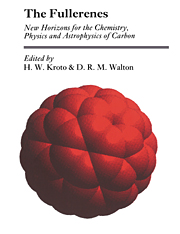Book contents
- Frontmatter
- Contents
- The evolution of the football structure for the C60 molecule: a retrospective
- Dreams in a charcoal fire: predictions about giant fullerenes and graphite nanotubes
- On the formation of the fullerenes
- Production and discovery of fullerites: new forms of crystalline carbon
- Systematics of fullerenes and related clusters
- The fullerenes: powerful carbon-based electron acceptors
- The carbon-bearing material in the outflows from luminous carbon-rich stars
- Elemental carbon as interstellar dust
- The pattern of additions to fullerenes
- Pollyynes and the formation of fullerenes
- Hypothetical graphite structures with negative gaussian curvature
- Fullerenes as an example of basic research in industry
- Deltahedral views of fullerene polymorphism
- Geodesic domes and fullerenes
The evolution of the football structure for the C60 molecule: a retrospective
Published online by Cambridge University Press: 03 February 2010
- Frontmatter
- Contents
- The evolution of the football structure for the C60 molecule: a retrospective
- Dreams in a charcoal fire: predictions about giant fullerenes and graphite nanotubes
- On the formation of the fullerenes
- Production and discovery of fullerites: new forms of crystalline carbon
- Systematics of fullerenes and related clusters
- The fullerenes: powerful carbon-based electron acceptors
- The carbon-bearing material in the outflows from luminous carbon-rich stars
- Elemental carbon as interstellar dust
- The pattern of additions to fullerenes
- Pollyynes and the formation of fullerenes
- Hypothetical graphite structures with negative gaussian curvature
- Fullerenes as an example of basic research in industry
- Deltahedral views of fullerene polymorphism
- Geodesic domes and fullerenes
Summary
By chance in 1970, we conjectured the possibility of the football-shaped C60 molecule, now known as buckminsterfullerene, while considering superaromatic molecules having three-dimensional π-electron delocalization. A translation of the original description, initially written in Japanese, is given. The processes leading to scientific discoveries are analysed in the light of our missed opportunity.
Introduction
The timescale of scientific and technological advance is becoming shorter and shorter in modern society, partly as a consequence of the rapid advance of technology and improving information transfer. It is no wonder then that the time has come to look back and discuss the future of fullerene science after less than a decade since its discovery by Kroto et al. (1985) and after only two years since it was isolated by Kratchmer et al. (1990). The purpose of this paper is to recount the story of original early proposal of the football-shaped C60 molecule back in 1970, and refer to other interesting ‘prehistoric’ events and analyse the process of scientific discovery.
Background
In the 1960s and 1970s, non-benzenoid aromatics were favourite targets for organic chemists. There was a prevailing dogma that aromaticity, due to the delocalization of π-electrons, is best realized in planar molecules. Everyone wished to constrain their molecules to be as planar as possible and for this reason aromaticity tacitly remained a two-dimensional concept. [18]Annulene (1), synthesized by Sondheimer et al. (1962), can be regarded as the masterpiece of planar aromaticity for its symmetric beauty (D6h) and high level of π-electron delocalization. In view of the wide availability and its perfect aromaticity, however, benzene remains the archetypal superstar of aromatic molecules.
- Type
- Chapter
- Information
- The FullerenesNew Horizons for the Chemistry, Physics and Astrophysics of Carbon, pp. 1 - 8Publisher: Cambridge University PressPrint publication year: 1993
- 2
- Cited by

